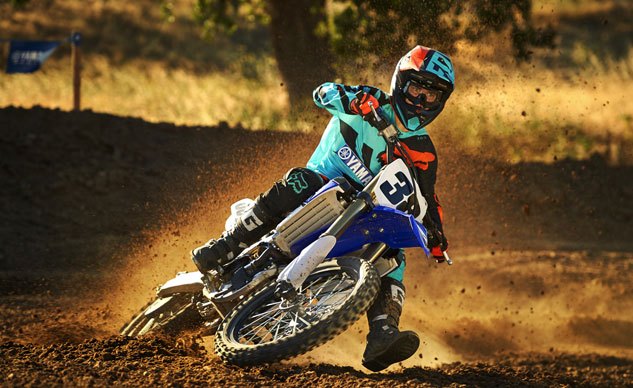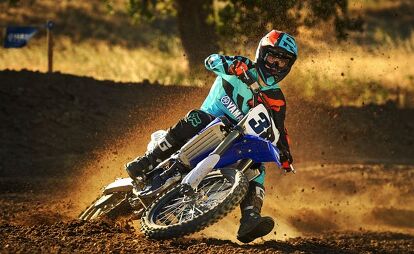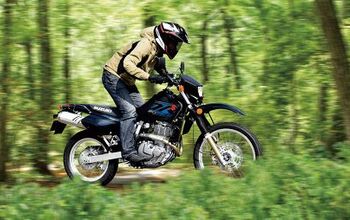2017 Yamaha Motocrossers And Off-Roaders Revealed
YZ250F and 250FX updated with many tweaks
For the first time in three years, Yamaha Motor Corporation has announced that it will not be releasing an all-new motocross or off-road motorcycle in its comprehensive dirtbike lineup.
We’re not surprised, as the bLU cRU has not only redesigned its flagship YZ450F and YZ250F in that time, it has also completely redesigned its WR450F, WR250F enduro models and introduced two new cross country-bred models, the YZ450FX and the YZ250FX. Heck, even the two-stroke family has gotten a lil’ love, with updated YZ250 and YZ125 motocrossers and the release of the first new Yamaha two-stroke off-road competition machine in decades, the YZ250X.
All that hard work has produced class-leading motorcycles in most of their competitive segments and helped to make Yamaha the leader in motocross share, according to the company. But even if Yamaha’s hard-working engineers deserve a break, they didn’t take one — at least not yet.
2017 Yamaha YZ250F
The 2017 YZ250F returns with a host of updates intended to make it even better. Yamaha’s quarter-liter four-stroke screamer has received 11 noteworthy engine changes and seven chassis changes.
Starting with the engine, Yamaha engineers felt the need to boost top-end performance without sacrificing the stout low-end and mid-range pull it already has. To do that, the 250F’s liquid-cooled, DOHC, four-stroke Single gets a new reversed cylinder head with revised intake and exhaust port shapes, and the intake side now boasts an even straighter angle to give the incoming fuel charge a more direct path to the 250F’s titanium intake valves. The effective length of the intake tract has also been reduced via a 15mm shorter air funnel above the F’s 44mm Keihin throttle body. The intake side of the throttle body has also been altered to match the shape of the intake port for improved air flow.
The 2017 YZ250F also receives new, more aggressive intake and exhaust camshaft specs to take advantage of the freer-breathing cylinder head, which also features larger valve seats than the previous head. Yamaha has also increased the diameter and changed the shape of the 250F’s wraparound mid-pipe in an attempt to boost top-end performance even more.
Enhancing the mechanical improvements, Yamaha also turned its attention toward the YZ250F’s ECU as well, altering the ignition and fuel mapping to the ideal settings for the new tune-up. The ECU also features revised rev limiter settings that give the YZ250F a better overrev feeling and a less abrupt cutoff by the rev limiter when the engine reaches its 14,000 rpm redline.
As part of the rotating group housed inside the compact engine cases, which are heat-treated for greater strength, the YZ250F also receives a new steel connecting rod that features more nickel content for greater durability in concert with the engine’s increased power output. Yamaha has also revised the YZ250F’s clutch and five-speed transmission to give both a more refined feel. The Yamaha’s cable-activated clutch receives a new arm ratio, bushing and cable to give the clutch a lighter-feeling and smoother action. The transmission now features increased second and third gear widths along with revised gear-tooth designs, and the radius on the first- third and fifth-gear shift dogs has been increased. The output shaft is also thicker and features new oil holes to reduce friction. Yamaha engineers also made a slight change to the groove position on the shift drum and switched a different shift lever shape to give the transmission a smoother shift feel.
The YZ250F’s bilateral beam aluminum chassis has received its fair share of praise over the past couple years, but Yamaha decided to make subtle changes in an effort to make it even better handling. When it comes to aluminum chassis, ideal flex is the name of the game, and the 2017 YZ250F’s flex character has been altered a couple ways. The forged swingarm pivot sections are now wider, increasing the total width of the frame by 12mm. The flex character has also been altered via new engine mounts that are shaped differently than the 2016’s mounts and also use steel rather than aluminum as the material for the lower mounts; the upper mounts are still made of aluminum. The only other change involves lowering the foot peg mounts by 5mm to help lower the chassis center of gravity while also making the YZ250F more accommodating for taller riders.
Same as in 2016, the YZ250F sports a fully adjustable 48mm KYB coil spring fork with Speed Sensitive damping, but the fork tubes have been changed slightly for 2017. They’re slightly thicker the base of the slider for increased rigidity. In fact, looking at them closely with the naked eye reveals a parting line as a visual clue to the increased thickness. Suspension travel is still 12.2 inches. Out back, a fully adjustable KYB monoshock with a massive 50mm piston inside its piggyback reservoir delivers 12.4 inches of travel through a rising-rate linkage system. The suspension settings at both ends have been revised to balance with the chassis.
Yamaha also made one change that we’re glad to see: Our 2016 YZ four-strokes had a weird tendency to lose the Dsuz fasteners that hold on the airbox lid. Sometimes we’d go riding and return only to find the fasteners on both sides missing. Apparently the problem stems from the quarter-turn fasteners being snagged by boots and knee guards, which caused the fasteners to open and fall off the machine. To deal with the issue, Yamaha redesigned the air filter cover with recesses to lessen the chance that the Dzus fasteners will be snagged and lost.
The 2017 YZ250F retains the 270mm front brake rotor and two-piston caliper introduced on last year’s model, but there has been a change to the 245mm rotor out back. The rear rotor is made of a new material that provides better heat resistance than the previous rotor.
Pricing for the 2017 Yamaha YZ250F has been set at $7,699.
2017 Yamaha YZ450F
Compared to the 2017 YZ250F, the 2017 YZ450F returns relatively untouched, although it does get the updated rear brake rotor material and the redesigned air filter cover. Other changes to the bigger YZ450F include a new Dunlop Geomax MX3S tires, a new countershaft oil seal and new oil strainer for improved reliability. The 2017 Yamaha YZ450 will retail at $8,699. Both the 250 and 450 models will once again be available in two color options — blue/white or white/red — and will be in Yamaha dealer showrooms in June.
2017 Yamaha Two-Strokes
On the two-stroke front, the Yamaha YZ250, YZ125, and YZ85 return for 2017. The YZ85 is unchanged except for new graphics. After undergoing suspension and cosmetics changes for 2015, the YZ250 and YZ125 are back for 2017 with new 270mm front brake rotors (up from 250mm) and new front brake pad material for improved braking performance.
The YZ250 is priced at $7,399, the YZ125 is $6,499, and the YZ85 is $4,099. All three two-stroke models will hit showroom floors in August.
2017 Yamaha Off-Roaders
Who would’ve ever thought there would come a day when Yamaha would have more off-road specific competition models on offer than all three of their Japanese rivals combined? The YZ250FX is so popular that it is the number-one selling closed-course country off-road model regardless of displacement category, according to Yamaha.
But since Yamaha was combing through the 2017 Yamaha YZ250F anyway, why not take advantage of those updates for the YZ250FX as well?
Sounds like a good idea to us. After all, the motocrosser begat the off-roader, although there are numerous features that differentiate the FX, such as electric starting, different transmission ratios, a different ECU and suspension tuning, and 18-inch rear wheel. For 2017, the YZ250FX receives more changes than the YZ250F, but those changes actually pull the two machines a little closer together in terms of their overall specifications.
Mechanically speaking, the YZ250FX is now nearer to the YZ250F. Its liquid-cooled, fuel-injected, DOHC, 249cc Single already shared the same 77.0 x 53.6mm bore and stroke, and the same 13.5:1 compression ratio, but for 2017 Yamaha updated the FX engine to more closely mirror the YZ250F, starting with the swap to the same bridge-box design piston, which shaves weight by 10%. The piston pin also receives Diamond-like Coating (DLC), and its underside is now cooled by an oil jet. Down below, the crankshaft now receives thrust washers to help reduce lateral crankshaft movement at high rpm. The crankshaft and counterbalancer have also been rebalanced to help give the engine a smoother, more predictable power delivery. Like the 250F, the FX also gets a new steel connecting rod with more nickel in the mix for better high-rpm reliability.
One FX specific change to the engine involves taking something away rather than adding it: For 2017 the YZ250FX (and YZ450FX) will be delivered from the factory sans kickstarter and kickstart mechanism. That means no backup is in place should your FX’s battery fail, but Yamaha is confident that its battery and starter system are up to the task of lighting off the bike as needed, and ditching the kick starter and required gears shaves a none-too-insignificant 1.74 lbs. off each machine. That’s a big difference, considering that the electric starter and larger generator added 18 lbs. of weight to the original FX when compared to the motocrosser.
Beyond that, the 2017 250FX gets the same engine changes as the 2017 YZ250F, and for the same reasons. To boost top-end power, the FX gets the new reversed cylinder head with revised intake and exhaust port shapes, and the intake side now boasts an even straighter angle to give the incoming fuel charge a straighter shot into the combustion chamber. The effective length of the intake tract has also been reduced via a 15mm shorter air funnel above the F’s 44mm Keihin throttle body. The intake side of the throttle body has also been altered to match the shape of the intake port for improved airflow.
To help fill the new cylinder head more efficiently, the FX features more aggressive intake and exhaust camshafts. Yamaha has also increased the diameter and changed the shape of the 250F’s wraparound mid-pipe in an attempt to boost top-end performance even more. The FX’s ECU has also been retuned, and it now features a more progressive rev limiter to give the engine a better overrev feeling and a less abrupt cutoff at its 14,000 rpm redline.
The YZ250FX’s clutch and five-speed transmission have also been refined. The cable-operated clutch receives a new bushing to give a lighter and smoother feel, and the second-, third- and fourth gears have been beefed up for increased strength. Yamaha engineers also opted for a different shift lever shape and material to give the transmission a smoother shift feel.
The YZ250FX’s bilateral beam chassis is also changed to give it a better flex character in the off-road environment. The forged swingarm pivot sections are now wider, increasing the total width of the frame by 12mm, and the engine mounts feature different shapes and material than the 2016. The upper mounts are still aluminum, but the lower mounts are now made of steel.
The YZ250FX’s fully adjustable 48mm KYB coil spring fork with Speed Sensitive damping has also been revised for 2016, including new fork tubes that are thicker in some spots along with new fork seals and a new fork scraper to protect against fouling by foreign materials. Front suspension travel is 12.2 inches. Out back, a fully adjustable KYB monoshock with a massive 50mm piston inside its piggyback reservoir delivers 12.4 inches of travel through a rising-rate linkage system. The suspension settings at both ends has been revised to balance the suspension performance with the upgraded chassis.
Also like the YZ250F, the YZ250FX gets a new air filter cover that better guards its quarter-turn Dsuz fasteners from being snagged by boots and knee guards and falling off the machine.
The 2017 YZ250FX also gets a new 270mm front brake (up from 250mm last year), and there has been a change to the 245mm rotor out back. The rear rotor is made of a new material that provides better heat resistance than the previous rotor. Other new features include a heavy-duty plastic skid place to protect the lower frame from rocks, roots and other objects, and a new fuel level sensor and warning light to indicate when the fuel level is getting low; these features were pirated from the WR250F.
The 2017 YZ250FX’s suggested retail price is $7999, and it will hit dealer showroom floors in August.
The rest of the 2017 Yamaha off-road lineup returns with minimal changes. The YZ450FX is back with new graphics and revised suspension settings. The 450FX’s 48mm KYB Speed Sensitive fork also receives the new oil seals for enhanced durability as well as the redesigned air filter cover and the WR-style fuel-level sensor and warning indicator. The 450FX will retail for $8999 and hit dealerships nationwide in August.
The 2017 Yamaha WR450F returns with new graphics and will retail for $9099. Ditto for the 2017 WR250F, which will retail for $8099. Both machines will be available in July. The 2017 YZ250X two-stroke will receive new graphics and will retail for $7499. It will be available in August. All of Yamaha’s off-road models will be available in blue/white. No optional color scheme will be offered as it is on the motocrossers.
More by Scott Rousseau































































































Comments
Join the conversation